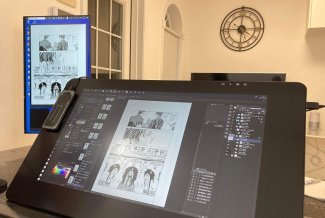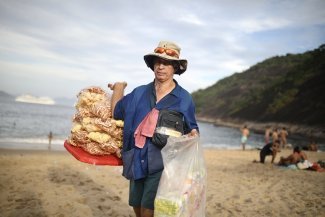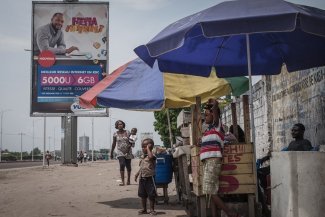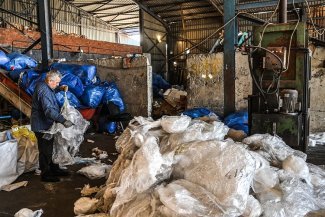A couple of scrap collectors discard the stones in which they have found no gold. Picture from 2017 at Las Brisas mine, on the outskirts of Segovia, in inland Colombia.
Luz Dary has spent more than half of her life in the mine. This 47-year-old Colombian woman is a chatarrera, a scrap collector: she toils away, every day, from six in the morning to six at night, alongside another 50 or so women in Las Brisas, on the outskirts of Segovia (a municipality in northwest Antioquia, in inland Colombia), selecting, washing and sifting the lumps of earth left to them by the miners (all men). She is looking for any valuable mineral remains, which will then have to be extracted in the workshops in the city, where the gold is separated from the scrap.
“It is a hard life, but at least it is a livelihood. What else can we do?” she says. Depending on the price of gold on the international markets, she earns between 150,000 and 280,000 Colombian pesos a month (between €44 and €81). At least 80 per cent of the population in Segovia (over 40,000 people) depend on mining for a living.
This hard life, which has always provided them with a living, at least, is now illegal. “The government calls anyone found with a few nuggets of gold a criminal. They are not able to sell it, because they don’t give licenses for that,” explains Freiman Gómez, a local journalist who is closely following the issue. The people of Segovia are calling for Bill 169 of 2016, which criminalises traditional mining, as well as Law 685 (2001) of the Mines Code, to be amended to include those whose communities have been involved in this activity, passed on from one generation to the next for over a century.
Around 83 per cent of the gold extracted in Colombia is unlicensed, according to a recent book La minería en el posconflicto: un asunto de quilates (Mining in the Post Conflict Era: A Matter of Carats).
The mining sector collected 2.61 billion pesos (approximately €757 million) during the second quarter of this year, which accounts for 1.9 per cent of GDP. In Colombia, the state owns the subsoil and the country’s non-renewable natural resources, in accordance with article 332 of the 1991 constitution.
For President Juan Manuel Santos, mining needs to become one of the “powerhouses” financing post-conflict Colombia, following the signing of the peace agreement with the FARC. The aim is to collect taxes from the big mining companies and attract foreign investment, but Colombia’s artisanal miners have been left out of the plan. The Colombian peace accord covers the need to provide coca growers with economic alternatives, allowing them to turn to legal crops, but offers no alternative to “Illegal” miners.
Social conflict
There are two sounds that never cease in Segovia: the deafening, repetitive sound of the machines crushing the scrap brought from the mine and the swarms of motorbikes driving through its streets. In July and August, they were joined by another sound: that of the clashes between locals and members of the anti-riot squad, ESMAD. What started out as a peaceful miners’ strike, on 21 July, turned into a battle that ended 44 days later, with three people dead, 25 injured and 32 detained, including 10 minors.
Segovia symbolises the first battle waged by traditional miners (deemed illegal by the state) against the government’s plans.
The Canadian multinational Gran Colombia Gold, which has been operating in the region since 2009 and controls the licenses for extracting and selling gold, is at the centre of the dispute. “The people are demanding solutions. The production chain needs to be guaranteed and the scrap merchants must be allowed to sell gold,” says Elióber Castañeda, president of the Mining Board of Segovia and Remedios, which called the strike.
“What is not fair is that they want to control 80% of the production from a concession that belongs to us,” responds José Ignacio Noguera, vice president of Gran Colombia Gold.
In 2015, the multinational extracted 116,857 ounces of gold (one troy ounce, the international measurement unit for gold, equal to 31.1 grams), from its two plants in Segovia and Marmato (a nearby town, in the department of Caldas). The companies website claims that its success impacts positively on the local communities. It is very difficult, however, to find anyone in Segovia that agrees with it.
Don Jorge is 70 years old and has been a miner since he was 15. Every day, he enters into a narrow and slippery tunnel and descends 120 metres into the bowels of the earth. The atmosphere is stifling. The only air circulating down there passes through a white plastic tube that he inhales when he needs to breathe. He works in a mine controlled by Gran Colombia Gold. “The workers have to put up with extremely poor operating conditions and the multinational collects the profits, without taking any risk,” denounces the journalist Freiman Gómez.
Looted by armed groups
Traditional miners also have to fight against the stigma around the connection made between them and armed criminal bands. The reality is that these mafias have them under a tight grip and demand payments from them in return for protection and permission to work. This link is one of the arguments the Colombian government is using to justify outlawing their work. During the protests, the defence minister, Luis Carlos Villegas, said, “There is evidence indicating that the Clan de Golfo is implicated in the Segovia incidents.”
Since the disappearance of the FARC, which completed the disarming of 7,000 guerrillas in September, the Clan del Golfo (a descendant of the paramilitary forces), has become the most powerful armed band in Colombia. In gold rich areas such as Segovia and Bajo Cauca, in Antioquia, their intimidating presence is visible in the form of the graffiti on houses and their iron grip is ensured by a sophisticated network of accomplices. Gold has become their core business interest, more than drugs, kidnapping and extortion.
Illegal mining, for the first time in recent history, is now generating greater profits than drug trafficking, according to the United Nations 2017 World Drug Report. The earnings derived from gold in Colombia are in excess of €2.4 billion a year, almost double the amount earned from the sale of heroin and cocaine.
Instead of simply attacking the armed mafias, the Colombian state is also targeting small and medium-sized businesses, according to Ramiro Restrepo, the president of the Bajo Cauca branch of the strongest mining trade union in the country, Asomineros. “They make us look like criminals,” he denounces. He explains that Decree 2235 of 2012 authorises state security forces to burn the machinery of miners who do not have a license. “It is sending us into ruin,” he adds.
A powder keg waiting to explode
Bajo Cauca, like the municipality near Segovia, is a powder keg waiting to explode. El Bagre is the operations hub of Mineros SA, a private Colombian company that controls the gold business in the region and plans to expand to the whole country and beyond (it is currently operating in the Bonanza region of Nicaragua).
The Mineros SA base camp, housing around 700 people (some 200 workers and their families), looks like a fort: 400 military reserve units are stationed there. They have suffered attacks and acts of sabotage by illegal groups; in addition to the Clan de Golfo, the ELN, the country’s second largest guerrilla force, with 3,000 armed fighters, is also present in the region. Helicopters are used to transport consignments, to stop them from being stolen. In 2016, the company earned over 407 billion pesos (€118 million), in Colombia alone, from its gold production sales, of which just 26 billion went to the state (€7.6 million), 6.4 per cent of the total.
All those we spoke to in Bajo Cauca expressed opposition to Mineros SA, with the exception of its employees. One of them was Wuilhmel Andrew, a member of the Green Party in Nechí, another nearby town. “My father was a miner, and his father before him. There is no other way of making a living in this area.” He says that the government is stopping them from working on the pretext that they are damaging the environment. “And Mineros SA isn’t polluting our land?” he asks.
Equal Times visited Mineros SA and spoke with several of its representatives. Carlos Mario Castaño, the environmental director, ensured us that the company complies with the legislation to protect the environment and spoke about a corporate social responsibility project that is having an impact on local communities. He acknowledges that there is a conflict and that they are under “enormous pressure”.
“Gold is giving rise to violence,” warns Julio Sampayo, a young member of the U Party in El Bagre. “The community is not feeling the benefits. These are very poor areas, even though they are rich in gold,” he says.
A succession of illegal dredgers, floating platforms from which miners work 12 hours a day, line the Nechí river. The impact of the mining here is manifest: the murky brown waters carry mercury and other harmful elements such as arsenic, lead or cyanide, and the deforestation on the hillsides is wreaking havoc. Colombia has the world’s highest level of mercury pollution, according to government data, and the worst affected area is Segovia, where mercury amalgamation is widely used to separate gold from waste.
The outlook is gloomy. Traditional miners are being displaced on a massive scale, stripped of their livelihood and their lands, and because the violence spawned by the gold rush has reached unbearable proportions. In regions such as Cajamarca, in Tolima (also in inland Colombia), a popular consultation was held on a mining megaproject and 98 per cent voted against it. In Segovia, an agreement was signed between the parties, but it has not yet translated into changes in the legislation. There is an uneasy calm in the region, as in Bajo Cauca. The gold war in Colombia is looming on the horizon.










